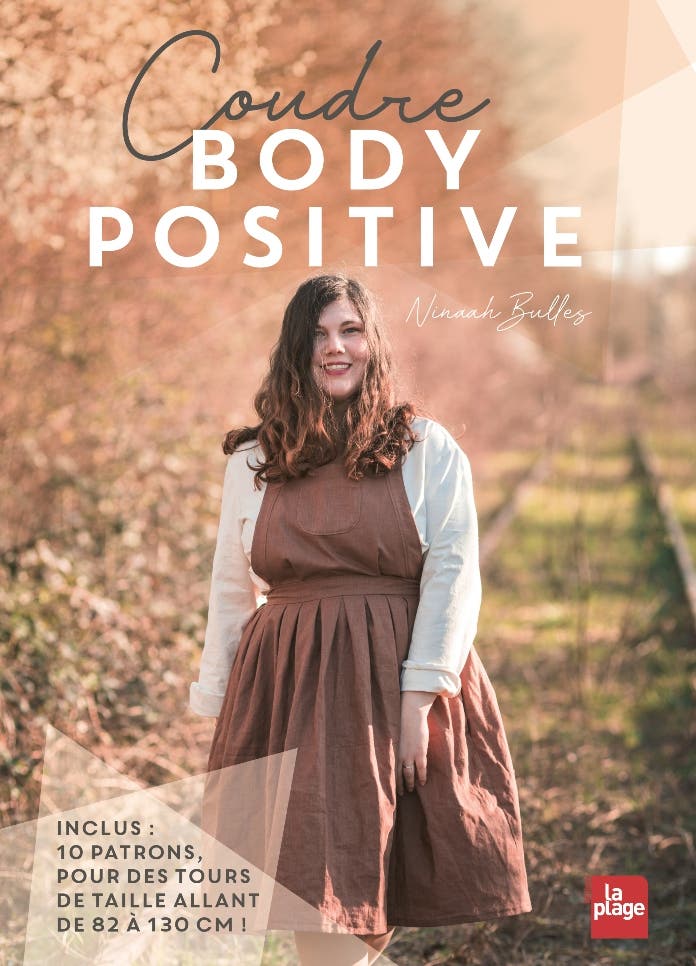There’s nothing smaller than the plus-size departments: Ninaah Bulles knows this all too well. This high fashion, lifestyle and travel blogger was published on June 2, 2021 Sew the body positively published by Éditions La Plage (128 pages, €24.95).
Faced with the normative offer of the dominant ready-to-wear, particularly fast fashion, which can give the impression of having the wrong body, she wrote this work that proposes to reclaim sewing as a guide towards self-acceptance.
Interview with Ninaah Bulles, author of Coudre body positive
This book also allows you to learn how to create or adapt ten pieces such as a shirt, blouse, dress or even a jumpsuit. She explains how sewing can be therapeutic, empowering and even feminist.
Madmoizelle: What is your first memory related to fashion?
Ninaah Bulles: I think my first fashion memory is more of a style memory. I’m not very fashionable, but more attracted to style. Having style was one of my desires as a young girl. And one of the events that inspired me the most as a child was Eurovision, there we saw the craziest and most eccentric styles and I loved it.
What made you want to learn to sew?
I have been sewing since I was a child. I started with my dolls’ clothes. I have always loved clothes and fabrics. I can’t explain it, it’s just how it is.
My teenage years were full of frustration, because I was always plus size and could find very few cute clothes that fit me. They were always badly cut.
Your torso is too high, your thighs are too narrow, your belly is too big, etc. I dreamed very early on that I could learn to sew to create the wardrobe of my dreams. A wardrobe with a unique and personal style, with cute doll dresses and puffed sleeves. I also have a particular obsession with folds and gathers. I put it everywhere. And it was in 2013 that I really started making my first clothes, after sewing accessories and decorative elements, all thanks to YouTube and Australian seamstress Annika Victoria.
What does “body-positive sewing” mean to you?
Sewing body positive means sewing with an intention, it means doing good. Sew for yourself, without constraints or fear of making mistakes. He uses couture as a weapon of emancipation from the dictates of the fashion industry. Be yourself and express yourself through your clothes. It means being in a positive and rewarding building process and becoming aware of your body. You don’t have to be handsome to have the right to dress up. It doesn’t have to be standard.
Your book suggests making or hacking 10 modular garments, which clearly demonstrates that it’s up to the clothes to adapt to us, and not us to adapt to the clothes. Do you think this part of common sense tends to get lost?
This part of common sense does not tend to be lost, it has been lost completely since the era of fast fashion dominated us. He is no longer mentioned or defended in the industry and has little presence in the sphere of ready-to-wear designers. In the world of couture, some designers, of which I am now a part, think about, draw inspiration from and rely on old methods and techniques of lacing, slides and other fasteners. They try to modernize them to include them in their models and make them more practical for everyday wear.
We live in a society where we still too often see people buying clothing that is too small and using it as motivation to transform and fit into it. Even if that means bending to this mold that isn’t made for them. While the role of clothing is to serve us. The roles are reversed.
And this is far from superficial or anecdotal. This leads to psychological suffering, strong complexes that can turn into depression or behavioral disorders. Because we lose confidence in ourselves and we are unable to love ourselves, to accept ourselves, because we do not fit into a mold imposed by modern society and fast fashion.
Among these 10 clothing items, which is your favorite and why?
It’s very difficult for me to answer this question, because I love them all. And above all I mix them together. I take the skirt from one, the top from the other, and the sleeves from a third pattern, and voila, I have another pattern that’s not in the book. In fact, my favorite clothes are all the ones I haven’t yet created from existing pieces.
To what extent can (re)learning to sew for yourself be a therapeutic, emancipatory and even feminist act?
I answer these questions more or less throughout my book. If I had to sum it up now, I would say that sewing taught me this failure is just a learning phase and is formative. Making a mistake even 3, 4 or 10 times doesn’t matter.
Sewing is emancipatory, because you can create your own style, and above all you can finally have tailor-made and comfortable clothes, which are like a second skin. Increases self-confidence.
We are taking back power. Today my wardrobe is 90% made up of clothes that I sewed myself and I love them all. They are all clothes that I feel good in. And if there’s something wrong, or an item I’ve tried on and it doesn’t fit me, I resell it or give it away.
Sewing acts like therapy. It allows me to clear my head, to create and to find myself in a cycle of positive construction, where I see a project being born little by little. But also becoming aware of my body, its shapes and its capabilities.
Sewing has allowed me to free myself from diktats, from so-called trendy styles and also to discover a community of women who support and care for each other. A little nod to my sewing collective, Marges included, my needle and gun sisters.
Why do you think most brands don’t offer plus sizes?
For a question of image and budget. Because yes, changing the size ranges means investing initially. After this investment, if done well, it yields much more than the initial investment. American pattern designer Cashmerette has revealed that its sales figures have quadrupled since it significantly expanded its size range.
Image-wise, there’s always this injunction to be a perfect, thin, young, pretty woman. Many brands still hide their plus-size departments in the back of the store, under an escalator. Others only offer large sizes on their e-shop. I find that few brands have really made an effort in the last ten years. I don’t think they care, and there’s still a lot of fatphobia in marketing. Brands don’t want big names in their stores.
View this post on InstagramA post shared by Ninaah Bulles 🧵 (@ninaahbulles)
Do you think that all models can be adapted to all body types or that some are better suited than others?
I talk about this in my book: any design can fit any body size, it just needs to be adjusted. It is above all a question of taste and style, specific to the person wearing the garment in question.
Sometimes we even surprise ourselves by changing our mind about a style of clothing, because we finally find the garment that fits our shape. For example, a few months ago I wrote in my book that you will never see me wearing culottes. I was convinced that this garment was not suitable for my body and my style. Then I found the perfect pattern, it fits me like a glove and I think I will sew it several times with different fabrics.
What advice would you give to those who want to dedicate themselves to sewing, but don’t dare, for fear of failure, of not being up to it?
My first piece of advice is to take the plunge! Failures and failures are part of the game, they are what allow us to learn and progress. Even today I often make mistakes, take them apart and start again. Sometimes I recycle a garment that I had sewn and that I no longer like and make something else with it.
Don’t necessarily start with an easy project or accessory, but with a project that really motivates you. And best of all, the sewing community is large and full of thoughtful people who you can ask for advice on social networks.
Next, if you are really afraid of starting on your own, you can look for a sewing club, a sewing cafe, you can afford some courses. There are associations and sometimes community centers that offer sewing courses and exchanges.

Other articles on
Grossophobia
-
“I have big breasts and that’s how it is”: Billie Eilish denounces the hypersexualization of women
-
Good news: These two essential documentaries about fatphobia are available on YouTube
-
Bridget Jones, Love Actually…Richard Curtis regrets the fatphobia and sexism of his films
-
Sexual harassment, assaults and kidnappings: Lizzo is the subject of a complaint filed by 3 former dancers
-
Because fat people have no choice but to dress in SHEIN
Do you like our articles? You’ll love our podcasts. All our series, urgently listen to here.
Some links in this article are affiliate links. We will explain everything here.
Source: Madmoizelle
Mary Crossley is an author at “The Fashion Vibes”. She is a seasoned journalist who is dedicated to delivering the latest news to her readers. With a keen sense of what’s important, Mary covers a wide range of topics, from politics to lifestyle and everything in between.




